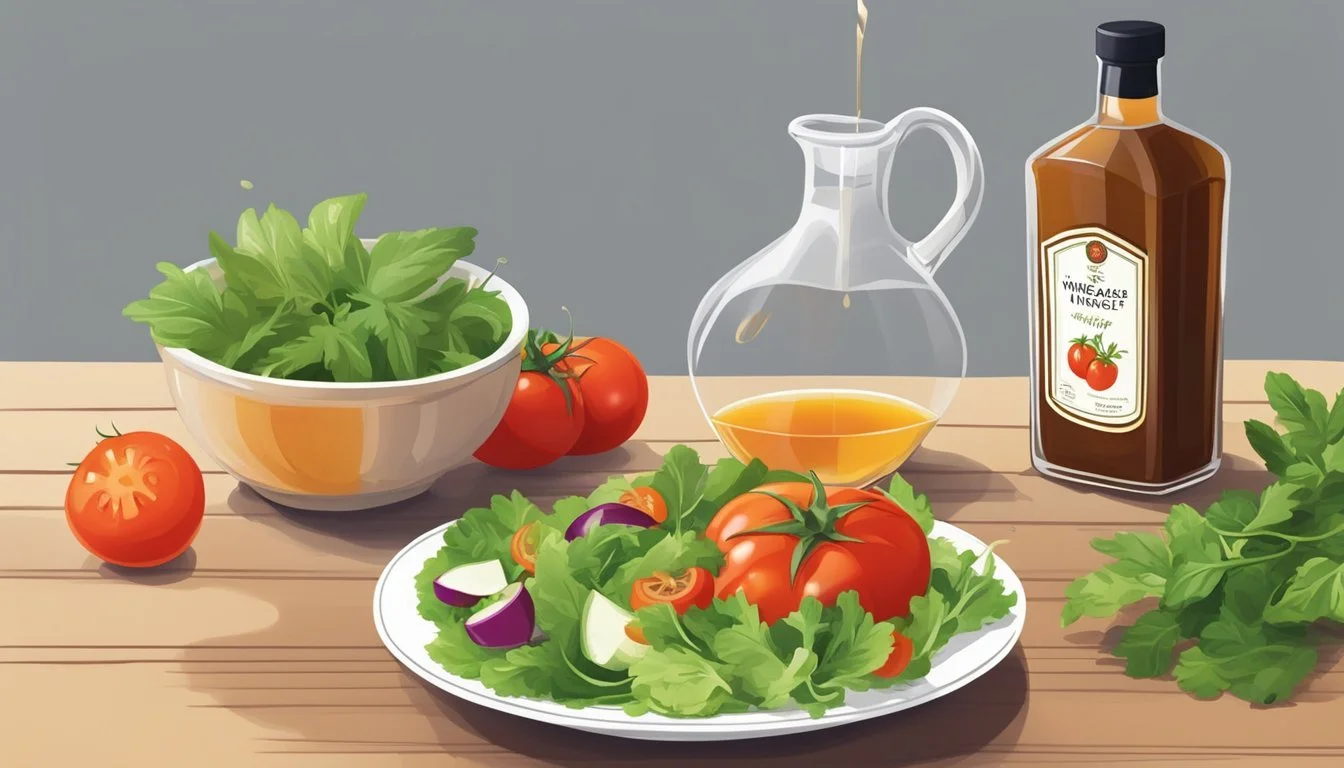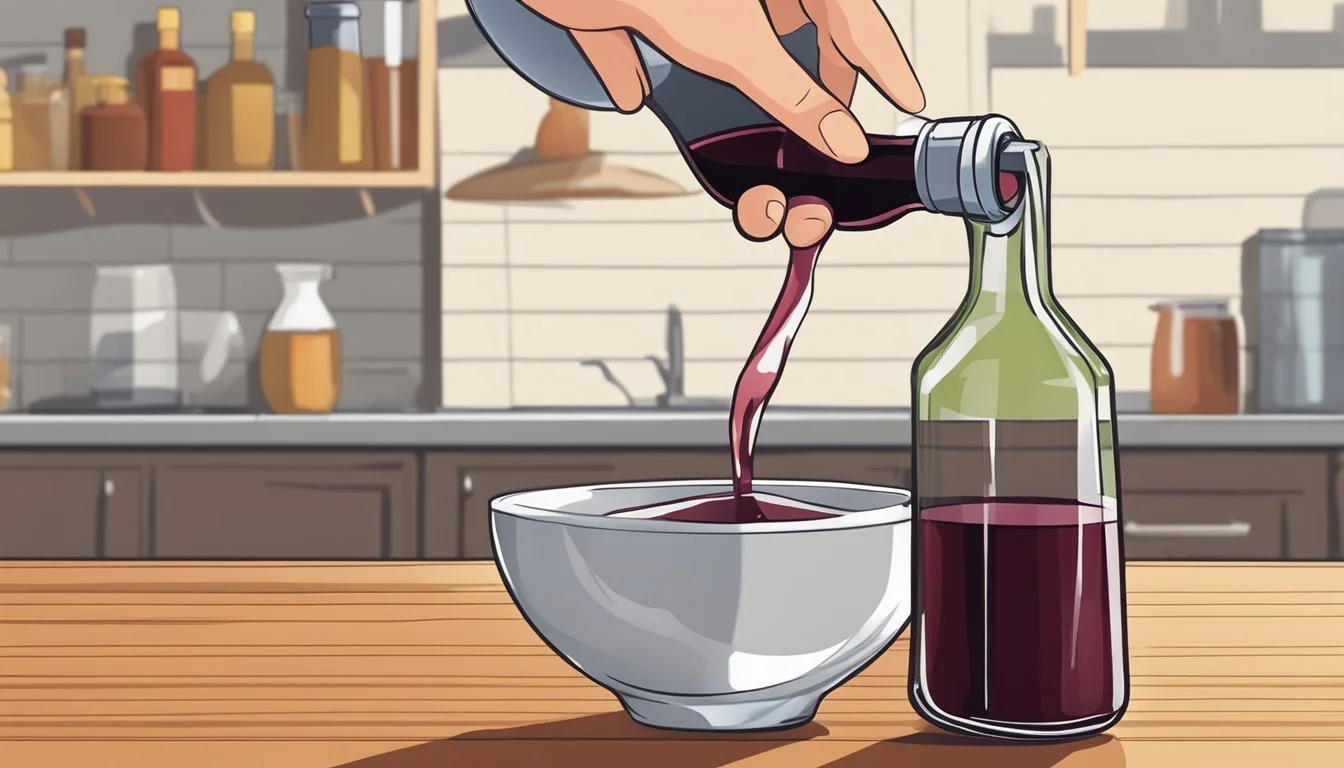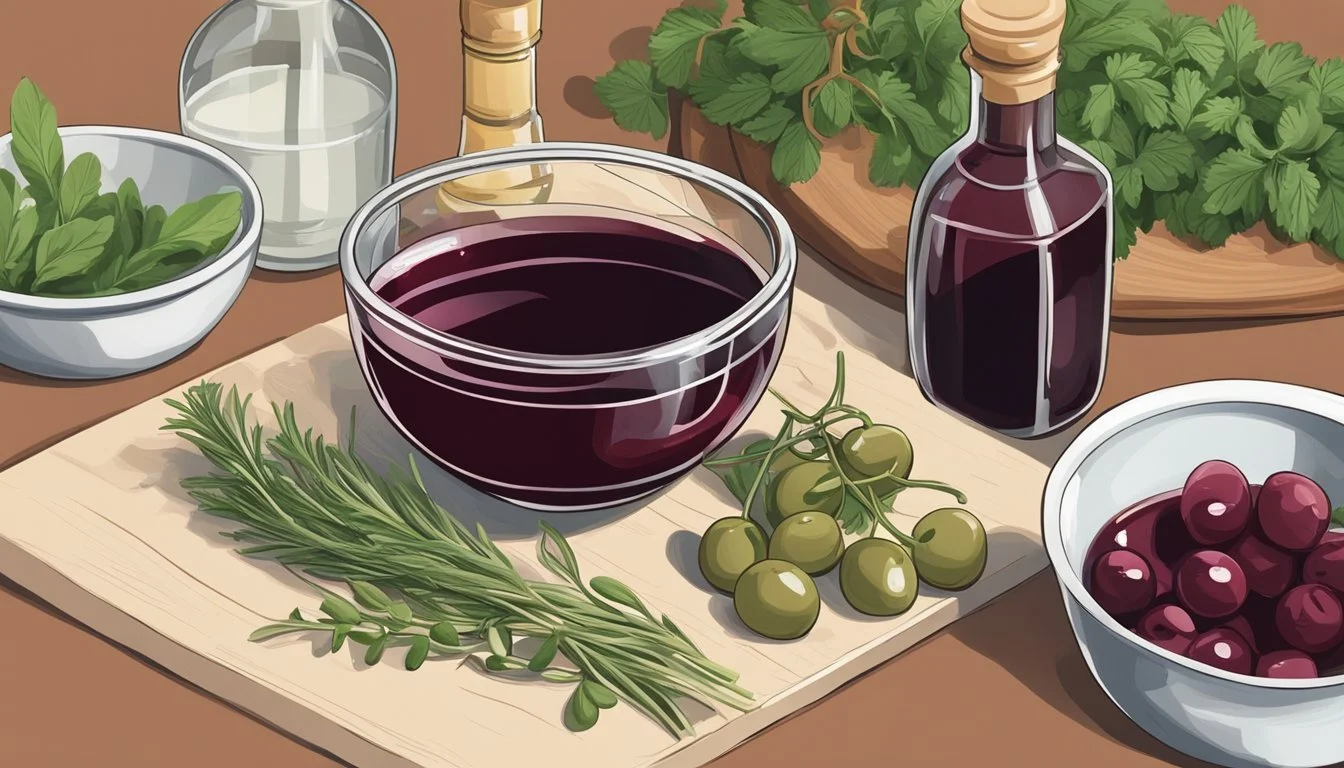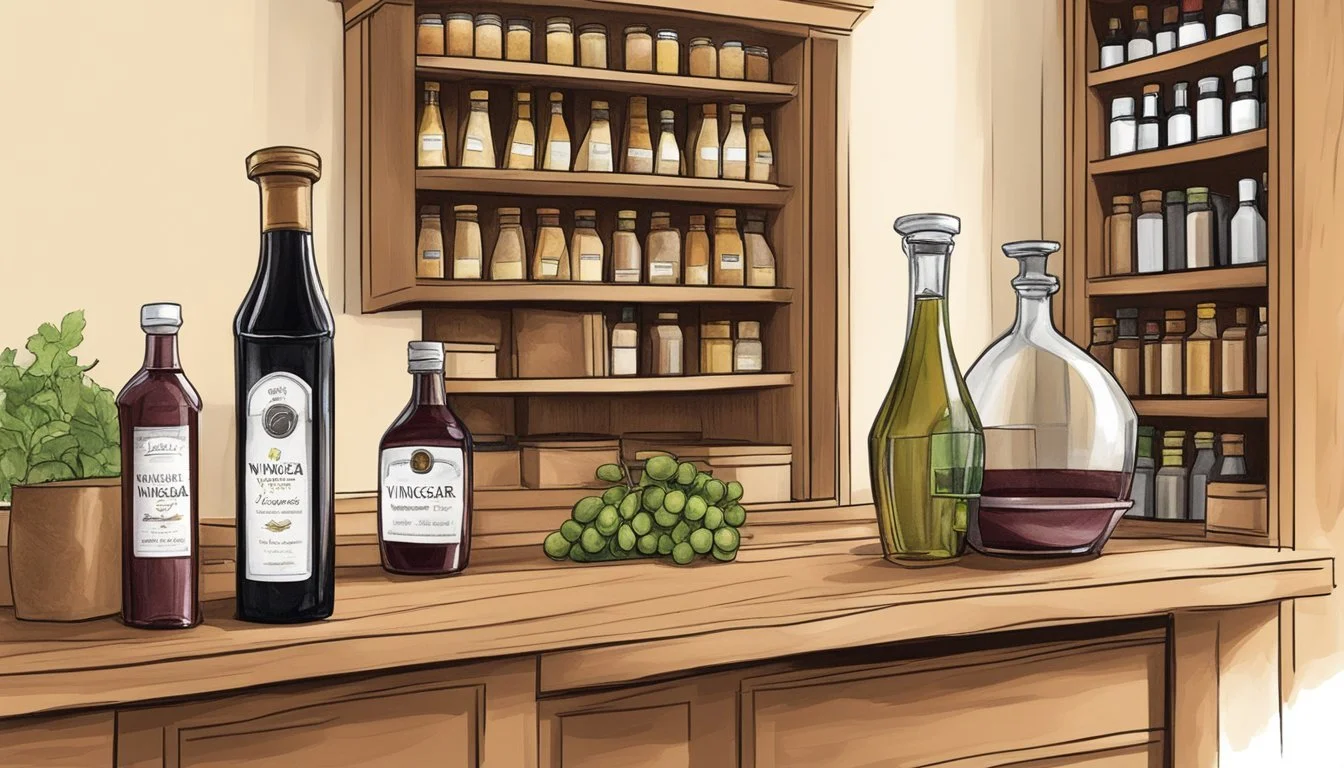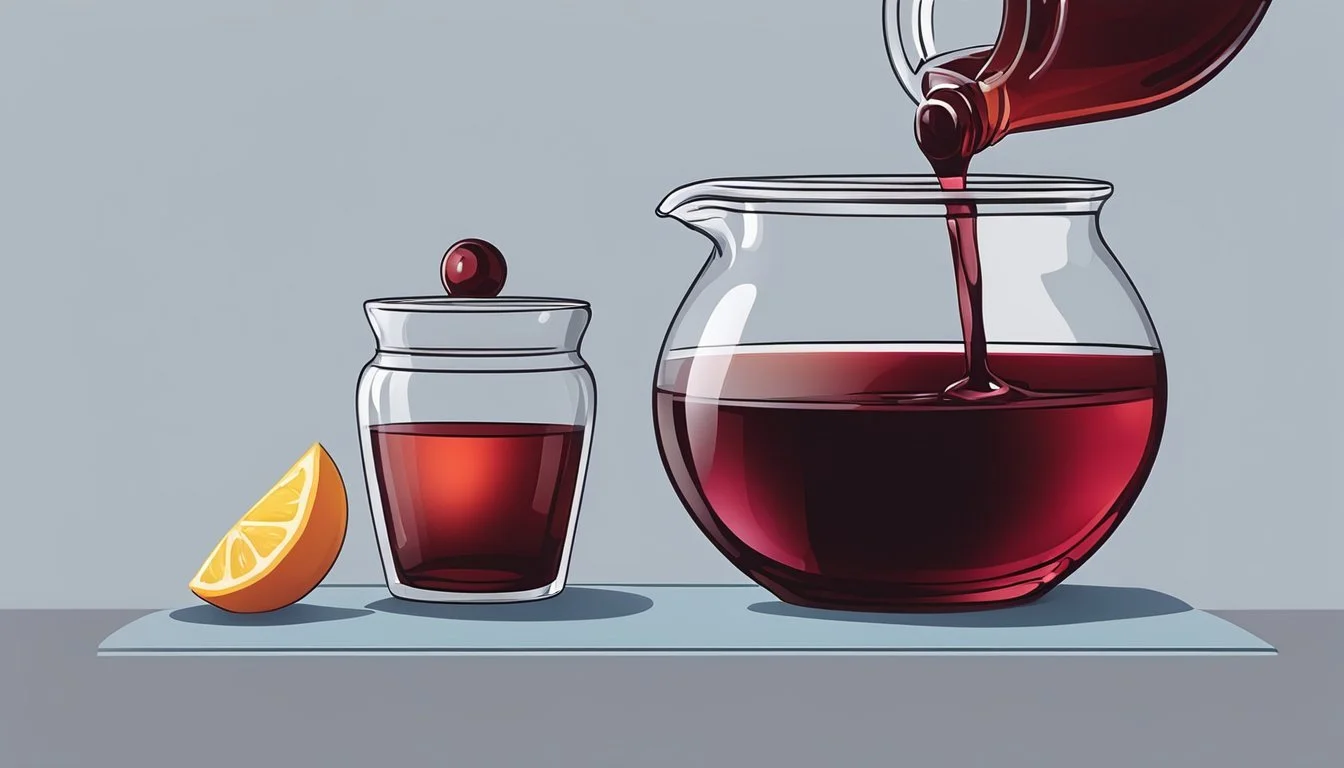How to Substitute Sherry Vinegar for Red Wine Vinegar
A Simple Guide
Sherry vinegar and red wine vinegar are important ingredients in the culinary world, each offering a unique taste to dishes. Sherry vinegar, created from sherry wine that has been fermented and aged, is known for its balanced acidity and subtle sweetness. It imparts a mellow, nutty flavor that's quite distinct from other vinegars. On the other hand, red wine vinegar, which is made by fermenting red wine, tends to have a sharper taste and is less sweet than sherry vinegar. It's a versatile ingredient that adds a robust flavor to a variety of recipes.
When substituting sherry vinegar for red wine vinegar in recipes, cooks need to consider the resulting alteration in taste and acidity. While both vinegars share a similar grape base, the aging process of sherry vinegar gives it a complexity that is not found in the more tart and potent red wine vinegar. Therefore, adjustments may need to be made to achieve the desired flavor profile.
In adapting recipes, it is important to use substitutes that complement the overall taste of the dish while maintaining the balance of acidity and sweetness. Since sherry vinegar is generally milder and has a nuanced flavor, starting with a slightly reduced amount of red wine vinegar can be a prudent approach. Season to taste, keeping in mind that the goal is to achieve a harmonious blend of flavors that enhances, rather than overwhelms, the other ingredients in the dish.
Understanding Vinegars and Their Uses
Vinegar is a versatile ingredient used in various cuisines worldwide, each variety presenting a distinct flavor profile and level of acidity.
White Wine Vinegar: This vinegar is fermented from white wine and is known for its moderate acidity and slightly fruity flavor. It's often used in vinaigrettes, marinades, and sauces.
Sherry Vinegar: Originating from the Spanish region of Andalusia, sherry vinegar is made from sherry. It features a balanced acidity with a rich, nutty flavor. It's a key component in authentic Spanish dishes and is excellent for enhancing the taste of soups, stews, and dressings.
Balsamic Vinegar: With its dark color and sweet taste, balsamic vinegar adds depth to salad dressings, glazes, and reductions. Balsamic vinegar has a higher acidity and a complex flavor, owing to the grape must used in its production.
Rice Vinegar: Milder and sweeter than many other vinegars, rice vinegar is a staple in Asian cooking. It is perfect for sushi rice, salad dressings, and pickling.
Apple Cider Vinegar: This vinegar has a tart, fruity taste that brightens up salads, marinades, and chutneys. It’s also noted for its potential health benefits.
Champagne Vinegar: Made from Champagne, it has a delicate, mild taste and a low acidity, making it suitable for light dressings and sauces.
When substituting one vinegar for another, it's crucial to consider the resulting change in acidity and flavor. Sherry vinegar, known for its well-rounded flavor, can often be replaced with red wine vinegar, bearing a similar acidity level. The substitution should be made considering the specific culinary application to maintain the dish's intended taste.
The Flavor Profile of Sherry Vinegar
Sherry vinegar, hailing from the Spanish province of Cádiz, carries a distinct flavor profile that chefs and culinary enthusiasts cherish. The vinegar is borne from the fortification process that Sherry wine undergoes, thus inheriting the wine's complex attributes.
Taste-wise, sherry vinegar presents a balance between acidity and sweetness, making it a versatile ingredient in various dishes. Unlike other vinegars, its acidity is often described as milder, lending a subtle tang without overwhelming the palate.
Its sweetness is not overt but rather nuanced, contributing to the depth of the vinegar's profile. This sweetness is typically accompanied by nutty undertones, which add to the richness of its flavor.
In terms of color, it tends to display a warm, amber hue, mirroring sherry wine. This characteristic color can also infuse dishes with a visually appealing aesthetic.
Flavor Components of Sherry Vinegar:
Taste: Balanced, with a milder acidity compared to other vinegars
Sweetness: Notably present but nuanced, does not overpower
Nutty Notes: Adds complexity and richness to its profile
Color: Exhibits a warm amber shade, similar to its wine counterpart
Sherry vinegar's unique flavor nuances make it a choice ingredient for dressings, glazes, and marinades. Its ability to provide a sophisticated taste profile allows it to enhance recipes without dominating other ingredients.
The Importance of Acidity in Cooking
In culinary practices, acidity plays a pivotal role, often acting as a crucial flavor balancer and preservative. Acidity levels, measured by pH, have significant implications for the taste, texture, and color of food.
Acidity in foods such as lemons, which contain lemon juice, and vinegars, rich in acetic acid, contributes to the sharpness and zest that brighten dishes. Acetic acid, specifically, provides pungent characteristics that can be manipulated to elevate the sensory appeal of cuisine.
Below is a brief list of acidity's roles in cooking:
Flavor enhancement: Acidity adds a distinct tartness that balances the richness and sweetness in foods.
Preservation: Low pH levels inhibit microbial growth, thereby extending shelf life.
Color retention: Acidic environments can prevent the discoloration of fruits and vegetables.
Marination: Acids tenderize meats by breaking down proteins.
For instance, while incorporating a substitute like red wine vinegar for sherry vinegar, chefs assess the acid's intensity and its resultant effect on the overall flavor profile. The chosen acid should complement the dish without overpowering other elements.
Acid Type pH Range Common Use Lemon Juice 2.0-2.6 Dressings, marinades, drizzles Red Wine Vinegar 2.6-3.0 Sauces, pickling, vinaigrettes
Chefs must carefully adjust the quantity to achieve the desired acidity level, as the unbalanced inclusion of an acidic component could result in a dish that's too tart or sour. By understanding these principles, cooking becomes a thoughtful art that pleases the palate and ensures food safety.
Red Wine Vinegar and Its Characteristics
Red wine vinegar emerges from the fermentation of red wine. This process converts the alcohol into acetic acid, imparting the vinegar with distinctive tartness and acidity. The characteristics of red wine vinegar can be discussed across various dimensions such as flavor profile, color, acidity level, and its relationship with the grape variety and aging process.
Flavor Profile: The flavor of red wine vinegar is robust and complex. It retains some of the flavors of the original red wine, giving it a fruity backdrop that complements its sharpness. It can range from light to rich and mellow, depending on the source wine and aging duration.
Color: Red wine vinegar, as the name implies, typically has a reddish-purple hue, mirroring its red wine origin. The intensity of its color is influenced by the type of grape and the concentration of wine used in its production.
Acidity: The acidity of red wine vinegar is pivotal to its use in culinary applications. Generally, it contains around 5-7% acetic acid. The acidity level contributes to the vinegar's ability to brighten flavors and to act as a preservative in pickling processes.
Grape and Aging Process: The type of grape used in making red wine vinegar affects its final taste and aroma. Grapes with varied characteristics yield vinegars with different subtleties in flavor. The aging process also plays a crucial role. Red wine vinegar that has been aged for longer periods will often have a softer, more rounded flavor compared to those that are younger, which tend to be sharper.
In essence, red wine vinegar offers a versatile flavor profile and acidity that can enhance many dishes, with its properties heavily influenced by the specifics of its production.
Substituting Sherry Vinegar for Red Wine Vinegar
When a recipe calls for red wine vinegar and there's none on the shelf, sherry vinegar is a practical substitute. Sherry vinegar is known for its rich, nutty flavor that can closely mimic the taste profile of red wine vinegar.
In terms of acidity, sherry vinegar is slightly milder than red wine vinegar. This variance can be addressed by using a 1:1 ratio as a starting point and then increasing the sherry vinegar by small increments to achieve the desired taste. This ensures the culinary uses harness both the subtlety of flavor and acidity required by the dish.
For flavor, sherry vinegar brings a slightly sweet and milder taste. It works well in sauces, dressings, and marinades where red wine vinegar is specified. While its flavor is distinct, it won't dominate other ingredients, making it a versatile addition to many recipes.
Here's a quick reference to guide the substitution:
Red Wine Vinegar Sherry Vinegar Notes 1 tablespoon 1 tablespoon Taste and adjust as necessary. 1/4 cup 1/4 cup Increase by teaspoon if needed. 1/2 cup 1/2 cup Ideal for marinades and sauces.
Chefs should taste as they go, considering the complex notes and desired acidity that sherry vinegar introduces. It's a decision that can align closely with the intended outcome of the dish, backed by the confidence that comes from understanding how these ingredients interact.
Determining the Correct Ratios for Substitution
When substituting sherry vinegar for red wine vinegar, the key to maintaining the integrity of the dish’s flavor profile is to use accurate ratios. Red wine vinegar typically has a robust flavor but it's slightly more pungent and less sweet than sherry vinegar.
For Marinades and Sauces:
A 1:1 substitution ratio works well, as the complexity of these dishes can handle and adapt to the change in vinegar variety without a significant shift in overall taste.
For Salad Dressings and Vinaigrettes:
Sherry Vinegar: Characterized by its milder and subtly sweet flavor.
Red Wine Vinegar: Known for its sharper and tangier taste.
Sherry Vinegar (Original Recipe) Red Wine Vinegar (Substitute) Notes 1 tablespoon 1 tablespoon Direct replacement maintains the dressing's structure. Add a pinch of sugar if additional sweetness is desired.
For Sauces Requiring Specific Acidity:
The cook should consider the role of vinegar in the recipe. If sherry vinegar is used for its milder tang, one might start with slightly less red wine vinegar and adjust to taste to ensure not to overpower the dish.
Taste Adjustments:
If a recipe requires the nuanced sweetness of sherry vinegar, one might add a touch of sugar to the red wine vinegar to balance the substitution.
Leveraging these ratios effectively allows for a seamless transition between the two vinegars in various recipes, ensuring that dishes maintain their intended taste and quality.
Recipes That Commonly Use Sherry Vinegar
Sherry vinegar, notable for its balanced acidity and subtle sweetness, is a versatile ingredient prevalent in many recipes. Here's an overview of dishes where it plays a key role:
Salad Dressings: Many chefs incorporate sherry vinegar in salad dressings for its ability to lend a complex flavor. A classic example is the vinaigrette, where it's whisked together with olive oil, herbs, and seasonings.
Marinades: Sherry vinegar is excellent for marinades, especially for meats and poultry. It helps tenderize the protein while infusing the meat with rich flavors.
For poultry, a mixture of sherry vinegar, garlic, and herbs can enhance the bird's natural flavors.
In beef marinades, it pairs well with soy sauce and ginger for an umami-rich profile.
Gazpacho: This cold, Spanish soup often calls for sherry vinegar to add a bright, tangy dimension to the tomato-based recipe. Its nuanced flavor complements the fresh vegetables without overpowering them.
Sauces and Glazes: Sherry vinegar can be reduced to create a flavorful glaze for meats or incorporated into pan sauces after deglazing, offering a touch of acid that balances fat and richness.
Recipe Type Use of Sherry Vinegar Salad Dressing Provides acidity and complexity to vinaigrettes Marinade Tenderizes and flavors meats, enhances poultry Gazpacho Adds brightness to the cold, vegetable-based soup Sauces and Glazes Offers a counterpoint to sweetness, enriches sauces
Chefs value sherry vinegar for its versatility across these and other culinary applications. Its unique flavor contributes to both the foundational and finishing touches of a dish.
Alternative Vinegar Substitutes
When one does not have red wine vinegar at hand, several alternative vinegar substitutes can be considered. These substitutes offer a range of flavors that can complement the dish similarly to red wine vinegar.
White Wine Vinegar is a close match to red wine vinegar, offering a similar level of acidity with a slightly lighter taste. It can be used in a one-to-one ratio but start with a little less and adjust to taste.
Rice Wine Vinegar, especially when unseasoned, presents a milder, slightly sweet flavor. To achieve the desired tanginess, a cook may need to use slightly more than the recipe's call for red wine vinegar.
Raspberry Vinegar provides a fruitier note, but its acidity levels make it a viable one-to-one substitute. It works particularly well in recipes that benefit from a slight fruit infusion.
Below is a summary table for quick reference:
Substitute Flavor Note Suggested Ratio to Red Wine Vinegar White Wine Vinegar Lighter, less acidic 1:1, adjust to taste Rice Wine Vinegar Milder, slightly sweet Use more than 1:1, to taste Raspberry Vinegar Fruity 1:1
Substitutes should be chosen based on the desired outcome of the dish and individual flavor preferences. White wine vinegar and raspberry vinegar are particularly suited for dishes that require a lighter or fruity note, whereas rice wine vinegar can provide a subtle sweetness. When using these substitutes, adjust quantities carefully to achieve the best balance in the final dish.
Health Benefits and Dietary Considerations
In the realm of vinegar selections, both sherry and red wine vinegars provide health benefits due to their fermentation process. The fermentation contributes to the presence of probiotics, which support gut health. These types of vinegar also contain polyphenols—antioxidants that may help protect the body against inflammation.
Regarding caloric content, vinegars typically have few calories, making them a low-calorie option for adding flavor to dishes. However, those watching their sugar intake should note that sherry vinegar can contain slightly higher sugar levels due to the sweeter sherry wine used in its production.
Allergy concerns are minimal with both types of vinegar, as they are generally free from common allergens. Still, individuals with histamine intolerance or who experience migraines may need to proceed cautiously, as fermented products can be triggers.
Here's a brief comparison:
Aspect Sherry Vinegar Red Wine Vinegar Fermentation Made from fermented sherry wine. Made from fermented red wine. Calories Low-calorie, similar to red wine vinegar. Low-calorie. Probiotics May contain beneficial bacteria. May contain beneficial bacteria. Polyphenols Antioxidants present. Antioxidants present. Sugar Content Slightly higher than red wine vinegar. Generally low. Allergens Rarely contains common allergens. Rarely contains common allergens.
In substituting sherry for red wine vinegar, consumers can rest assured that the health benefits are comparable, allowing for a switch that is unlikely to affect dietary restrictions or calorie counts significantly. It’s always advisable for individuals to consult with a healthcare provider if they have specific dietary concerns or conditions.
Storing Vinegars in Your Pantry
When it comes to maintaining the quality of vinegar, one's pantry can be an optimal storage location if conditions are right. Vinegars are pantry staples with a considerable shelf life, yet, proper storage is key to preserve their freshness and flavor.
For an ideal storage environment, keep vinegars in a cool, dark place such as a pantry or a kitchen cupboard away from heat sources. This ensures they remain at a stable temperature and are not subjected to light which can degrade the quality over time.
Vinegar should be tightly sealed in its original container. Proper sealing prevents oxidation and contamination from external odors, which could alter the taste.
Here is a quick reference on storing different types of vinegar:
Type of Vinegar Color Recommended Storage Sherry Vinegar Amber Cool, dark pantry shelf Red Wine Vinegar Reddish Cool, dark pantry shelf
It is not advisable to store vinegar in metal containers as it can react with the metal. Glass or plastic is typically most suitable. Vinegar's acidity means it has natural preservative qualities, allowing it to keep well for extended periods when stored correctly.
The specific shelf life can vary, but generally, vinegar has an indefinite shelf life and its acid nature even allows it to self-preserve. However, it's prudent to taste vinegar before use if it has been stored for an extended period, to ensure the flavor remains uncompromised.
Exploring Regional Vinegar Varieties
When substituting sherry vinegar with red wine vinegar, it's helpful to understand the regional and flavor profiles of these vinegars. Sherry vinegar originates from Southern Spain and is made from sherry wine. It's aged in wooden barrels, providing it with a complex, nutty flavor.
Spain's Sherry Vinegar:
Aged: Acquires a rich, nuanced taste over time.
Origin: Cadiz province, specifically the "Sherry Triangle" in Andalusia.
Flavor: Ranges from mellow to intense, with hints of the oak it's aged in.
Champagne vinegar, on the other hand, hails from the Champagne region of France. It's known for its delicately light and fruity profile, stemming from the region’s prestigious sparkling wine.
France's Champagne Vinegar:
Base: Derived from Champagne.
Flavor: Less acidic, with a subtle sweetness and floral aroma.
When choosing a substitute for sherry vinegar, one should consider the intended flavor profile for the dish. While red wine vinegar is a common replacement, its flavor is more straightforward and less complex than its aged Spanish counterpart. It doesn't carry the same depth that comes from the traditional aging process in Spain, but it can still impart a similar acid content to dishes where the nuanced flavors of sherry vinegar are not the centerpiece.
DIY Vinegar Making at Home
When one desires to create homemade vinegar, the process of fermentation is key. Engaging in the craft of vinegar making harnesses the power of beneficial bacteria to transform alcoholic liquid into tangy vinegar through a carefully controlled aging process.
Ingredients and Materials:
A wide-mouthed glass jar or bowl
Cheesecloth or breathable material to cover
A rubber band or string to secure the cover
Sherry wine or any wine at hand for fermenting
Vinegar starter (mother of vinegar or live unfiltered vinegar)
Step-by-Step Process:
Preparation: One should fill their chosen jar or bowl with the sherry wine.
Inoculation: Introduce the vinegar starter into the wine to jumpstart fermentation. This starter contains acetic acid bacteria necessary for the conversion.
Ratio Instructions Sherry Wine Full strength Vinegar Starter A portion to match the wine volume
Fermentation: Cover the container with a breathable cloth and secure with a rubber band. This allows for air circulation while keeping out contaminants.
Aging Process: Store the container in a dark, warm area where the mixture can sit undisturbed. One should allow several weeks for the fermentation to take place, tasting periodically to determine if the vinegar has reached the desired acidity level.
Throughout the process, the homemade vinegar develops its character and flavor profile. The aging time may vary, typically ranging from a few weeks to several months. Patience is a virtue in this craft, as a longer aging period can lead to a more complex and mellow vinegar. Once the vinegar reaches the preferred acidity, it can be strained and stored in bottles for regular use.
Pairing Vinegars with Foods
When substituting sherry vinegar with red wine vinegar, one must consider the food pairings to retain flavor harmony. Red wine vinegar, characterized by its tartness and hint of sweetness, complements a variety of dishes.
Seafood
For seafood, the vibrant acidity of red wine vinegar can be a brilliant match, enhancing the natural flavors without overpowering them. It is particularly suitable for ceviches or seafood salads where the vinegar's presence is integral to the dish.
Shrimps: A splash of red wine vinegar can elevate shrimp cocktail sauce.
Scallops: A light drizzle can accentuate the sweetness of pan-seared scallops.
Poultry and Red Meat
With poultry, a red wine vinegar marinade can tenderize the meat and add a flavorful depth. For red meats, it can be part of a robust marinade, especially for grilling.
Chicken: Use in marinades for grilled or roasted chicken for a zestful tang.
Beef: A red wine vinegar-based sauce can cut through the richness of red meats.
Vegetables
Vegetables can benefit significantly from red wine vinegar, especially when pickling or dressing salads.
Leafy Greens: Mix with olive oil for a classic vinaigrette.
Root Vegetables: Enhance roasted root vegetables with a dash before serving.
Protein-Rich Dishes
In protein-rich dishes, red wine vinegar works well to balance the dish's heaviness, offering a refreshing contrast to the palate.
Lentils: Add into lentil salads for a bright note.
Beans: Stir into bean salads for added zest.
To conclude, careful pairing of red wine vinegar with various foods can successfully mirror the intended effect of sherry vinegar in recipes, sustaining the dish’s overall flavor profile and integrity.
The Role of Vinegar in Marinades and Dressings
When crafting culinary delights such as marinades and salad dressings, the choice of vinegar is pivotal. It serves not just as a flavor enhancer but also plays a crucial role in the chemistry of cooking.
Marinades: They rely on ingredients like vinegar to tenderize proteins and infuse them with flavor. The acidity of vinegar, such as sherry vinegar, breaks down muscle fibers and connective tissues, making the meat more tender. In marinades, the substitution of red wine vinegar for sherry vinegar should be done in equal measure, mindful of the boldness red wine vinegar brings to the table.
Flavor Profiling: Vinegars add a desirable tang and can balance the richness of oils in dressings. Sherry vinegar offers a complex, slightly sweet note, often paired with herbs to elevate the aromatic quality of a dish.
Salad Dressings: A well-composed dressing requires a balance of flavors. Vinegar brings a bright, acidic component essential for cutting through the fattiness of oils. The nuances of vinegar types can complement different salad ingredients, with red wine vinegar adding a fruity yet robust taste.
Seasoning & Aroma: The two vinegars in question incorporate distinct seasons and scents to dishes. While sherry vinegar introduces a warm aroma, red wine vinegar is characterized by its fruity overtones. They both become conduits for seasoning as they meld with herbs and enhance the natural aromas of the other dressing or marinade components.
Delicate use of vinegar can make or break a dressing or marinade; thus, understanding their impact is crucial for any cook looking to induce the right balance of taste and tenderness in their culinary creations.



